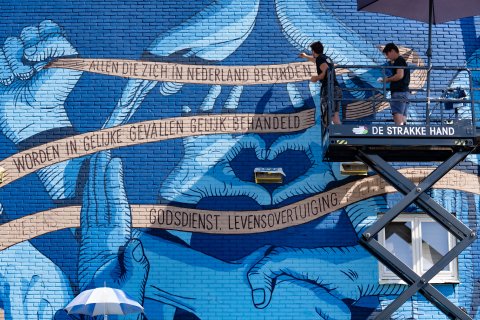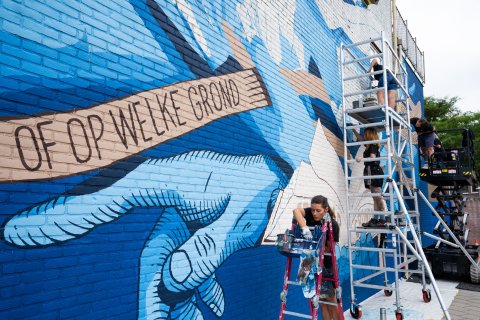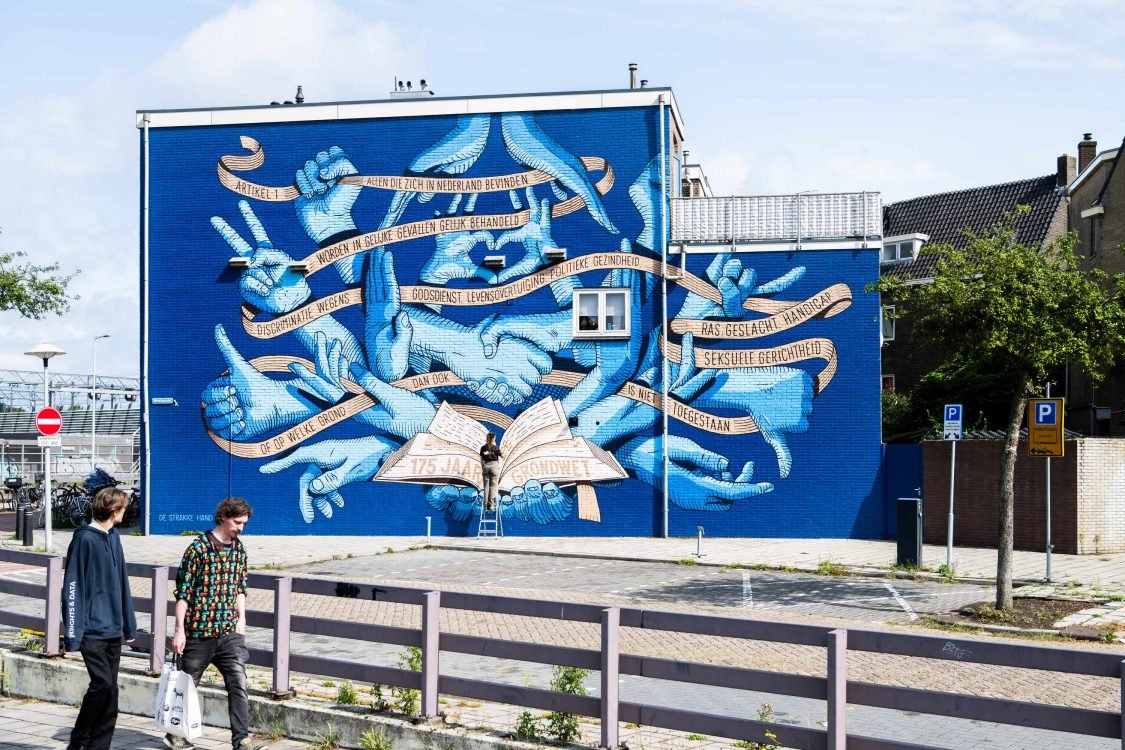Giel and Marc organised a striking mural on the Dutch Constitution

A metre-high mural highlighting the value of the Dutch Constitution and Article 1 in particular, can be seen at one of Utrecht's busiest intersections, near Central Station and the Ulu mosque. Law students Giel Heeringa and Marc Hanna took the initiative. They wanted to bring this beautiful article, that of equal treatment of people, and the Constitution as a whole, to life among young people. The 175th anniversary of the Constitution of the Netherlands is on 3 November.
The idea came about during a study assignment. How did that go?
Giel: It was in the second year of the Utrecht Law College. In a Constitutional Law course, we had a guest speaker, emeritus professor Bas de Gaay Fortman, who inspired us enormously. We were given the assignment 'design your own constitution' and it was allowed to have a maximum of 25 articles. Almost all students had to cut back considerably on their texts and ideas.
Marc: Bas de Gaay Fortman made us realise that Article 1 is actually the most beautiful and the most important. It also begins so beautifully with the words 'All who are in the Netherlands...' In addition, the Constitution as a whole is very important. It is a precious asset. We think about that far too little.
Why is the Constitution never in our thoughts?
Marc: The text is hard to read. And people sometimes critically say it doesn't matter much that we have a Constitution. It says that we have a fundamental right to housing. But what good is that if you can't find an affordable house anywhere?

The courts in the Netherlands are also not allowed to test against the Constitution, in other countries they do.
Giel: The minister is working hard to make this possible, though. During the corona pandemic, fundamental rights came to life a bit more. For instance, when gatherings with many people were banned, but church services continued because of religious freedom. And also when schools closed and curfews were imposed, people became more aware of fundamental rights.
Giel: Then the Constitution also came up in the Wellfare fraud scandal (in Dutch: Toeslagenaffaire). Thousands of families were wrongly accused of child welfare fraud. Parents' fundamental rights were violated there. Parents from migrant backgrounds were unfairly suspected of fraud and subjected to stricter controls. People were not treated equally. A textbook example of how, in practice, we are not sufficiently aware of Article 1 and its importance.
We all should pay more attention to the Constitution, it should be taught in school lessons.
Marc:We think much more attention should be paid to this, for example in lessons in schools. The values of the Constitution should never be cast aside without discussion.
What are we looking at, in the artwork? What do those hands mean?
Marc: It's good to be careful when explaining art. People should be able to have their own associations with images. The hands, however, have meaning. Our teacher - and artist herself - Pauline Phoa gave us the ideas of the hands and imagery to convey our message. The two unfolded hands at the top symbolise 'protect, cherish'. There are also hands at the bottom of the painting, carrying the book and all the hands together carry a banner, a ribbon with the text of Article 1. Together, we all carry the Constitution.

It also features a hand saying 'stop', as it were, with the palm facing forward. That symbolises in short: 'government, you can only go up to here and no further.' Elsewhere, you see the hand with the rock 'n roll fist with the fingers raised. That one symbolises freedom. The hand with two fingers up is often raised as a peace sign. We did review all the hand gestures with several people from different cultures to make sure everyone accepted them as peaceful symbols. We have given some thoughts to the choice of colour in the mural. There were different colours in the design, but we settled on blue as the colour of integrity and trust. And all the hands therefore are painted in the same colour, because they are equal.

How did the neighbourhood react to the plan?
Giel: We went house by house in the neighbourhood to ask residents personally if they support this initiative. That included fellow students Olivia Mus and Everard van Weede. Fortunately, we also received support from the municipality of Utrecht and, more specifically, Wijkbureau West. They supported our idea. Wijkburau West was of great help in communicating the plan to local residents. It also helped that the artists of De Strakke Hand had already created a beautiful mural on a wall nearby, The Sleeping Mars.
We went house by house in the neighbourhood with a group of students to ask residents if they support this initiative.
Marc: There were three kinds of reactions to our idea. Most local residents were positive and put their signatures immediately. There were also people who were more critical. They were not negative about the design, but mainly felt that there are many things in the Constitution that are not well regulated at all in the Netherlands. So does it deserve a pedestal? We had good conversations about that. There was a third category of reaction, namely people who were indifferent to it. That is the most difficult category. Actually, it is precisely them you want to reach and enthuse.

After those visits to local residents, talking about our plan, I was invited by the Hogeschool Utrecht to give an assignment for first-year HBO law students in the course "Legal Design Thinking". The assignment focused on those indifferent people. Can you use communication to generate support or interest in the subject of the Constitution? Great fun to do.
It took a few years to succeed. How have you kept your motivation?
Giel: Constitutional law is always been of interest to me, I love to promote its importance. So persevering took little effort. The partners we had for the mural, the law firm Pels Rijcken, the municipality of Utrecht, the housing association Woonin (then Mitros) and the artists of De Strakke Hand also gave us a lot of confidence. They wanted it to succeed too, so together you can remove practical obstacles. The people of De Strakke Hand had a good connection with the housing association Woonin. We owe that prominent, beautiful spot in the city, to that bond.
Marc: I knew that the 175th anniversary of the Constitution was a great 'window of opportunity'. So when it all took a little longer, I thought: as long as it works out before or around that date, then it's good. Next to that, it was a very fun project.
And what is it like for you personally, to stand in front of the mural now?
Giel: I immediately said to Marc: 'Wow, the book alone is much bigger than I am! Crazy!' It's awe inspiring.
Marc: It is impressively large and so beautiful. We are extremely proud and happy.
About the initiators
Giel Heeringa has recently graduated and is a lecturer in constitutional law, administrative law and legal theory at Utrecht University since August 2023. Marc Hanna has started the Legal Research Master programme at Utrecht University in the academic year 2023-2024.
Together they won the Social Impact Prize from the Faculty of Law, Economics, Governance and Organization in June 2023.
Partners
The mural was made possible by:
- Gemeente Utrecht
- Pels Rijcken law firm
- Utrecht University
- Housing association Woonin




